Question 1.
Check whether the following are quadratic equations.
i) (x + l)2= 2(x-3)
Answer:
Given: (x + l)2= 2(x - 3)
⇒ x2+ 2x + 1 = 2(x - 3) = 2x - 6
⇒ x2+ 2x + l - 2x + 6 = 0
⇒ x2+ 7 = 0 is a Q.E.
ii) x2- 2x = (-2) (3 - x)
Answer:
Given: x2- 2x = -2(3 - x)
⇒ x2- 2x = -6 + 2x
⇒ x2- 4x + 6 = 0 is a Q.E.
iii) (x-2) (x + 1) = (x- 1) (x + 3)
Answer:
Given: (x - 2) (x + 1) = (x - 1) (x + 3)
⇒ x (x + 1) - 2 (x +1)
= x (x + 3) - 1 (x + 3)
Note : Compare the coefficients of x2 on both sides. If they are equal it is not a Q.E.
⇒ x2 + x - 2x - 2 = x2+ 3x - x -3
⇒ x2- x - 2 = x2+ 2x - 3
⇒ 3x - 1 = 0 is not a Q.E.
iv) (x - 3) (2x + 1) = x(x + 5)
Answer:
Given: (x - 3) (2x + 1) = x(x + 5)
⇒ x (2x + 1) - 3 (2x + 1) = x . x + 5 . x
⇒ 2x2+ x - 6x - 3 = x2+ 5x
⇒ 2x2- 5x - 3 - x2- 5x = 0
⇒ x2- 10x - 3 = 0 is a Q.E.
(or)
Comparing the coefficients of x2 on both sides.
x . 2x and x . x
⇒ 2x2and x2
2x2≠ x2
Hence it’s a Q.E.
v) (2x - 1) (x - 3) = (x + 5) (x - 1)
Answer:
Given: (2x - 1) (x - 3) = (x + 5) (x - 1)
⇒ 2x (x - 3) -1 (x - 3) = x (x - 1) + 5(x - 1)
⇒ 2x2- 6x - x + 3 = x2- x + 5x - 5
⇒ 2x2-7x + 3 - x2- 4x + 5 = 0
⇒ x2- 11x + 8 = 0
Hence it’s a Q.E.
(or)
Co.eff. of x2on L.H.S. = 2 × 1 = 2
Co.eff. of x2on R.H.S = 1 × 1 = 1
LHS ≠ RHS Hence it is a Q.E.
vi) x2+ 3x + 1 = (x - 2)2
Answer:
Given: x2+ 3x + 1 = (x - 2)2
⇒ x2+ 3x + 1 = x2- 4x + 4
⇒ 7x - 3 = 0 is not a Q.E.
vii) (x + 2)3= 2x (x2- 1)
Answer:
Given: (x + 2)3= 2x(x2- 1)
⇒ x3+ 6x2+ 12x + 8 = 2x3- 2x [∵ (a + b)3= a3+ 3a2b + 3ab2+ b3]
⇒ -x3+ 6x2+ 14x + 8 = 0
is not a Q.E. [? degree = 3]
viii) x3- 4x2- x + 1 = (x - 2)3
Answer:
Given : x3- 4x2- x + 1 = (x - 2)3
⇒ x3- 4x2- x + 1 = x3- 6x2+ 12x - 8
⇒ 6x2- 12x + 8 - 4x2- x + 1 = 0
⇒ 2x2- 13x + 9 = 0 is a Q.E.
Question 2.
Represent the following situations in the form of quadratic equations:
i) The area of a rectangular plot is 528 m2. The length of the plot (in meters) is one more than twice its breadth. We need to find the length and breadth of the plot.
Answer:
Let the breadth of the rectangular plot be x m.
Then its length (by problem) = 2x + 1.
Area = l . b = (2x + 1) . x = 2x2+ x
But area = 528 m2(∵ given)
∴ 2x2+ x = 528
⇒ 2x2+ x - 528 = 0 where x is the breadth of the rectangle.
ii) The product of two consecutive positive integers is 306. We need to find the integers.
Answer:
Let the consecutive integers be x and x + 1.
Their product = x(x + 1) = x2+ x
By problem x2+ x = 306
⇒ x2+ x - 306 = 0
where x is the smaller integer.
iii) Rohan’s mother is 26 years older than him. The product of their ages after 3 years will be 360 years. We need to find Rohan’s present age.
Answer:
Let the present age of Rohan be x years.
Then age of Rohan’s mother = x + 26
After 3 years:
Age of Rohan would be = x + 3
Rohan’s mother’s age would be = (x + 26) + 3 = x + 29
By problem (x + 3) (x + 29) = 360
⇒ x(x + 29) + 3(x + 29) = 360
⇒ x2+ 29x + 3x + 87 = 360
⇒ x2+ 32x + 87 - 360 = 0
⇒ x2+ 32x - 273 = 0
⇒ x2+ 39x - 7x - 273 = 0
⇒ x (x + 39) - 7 (x + 39) = 0
⇒ (x - 7) (x + 39) = 0
⇒ x = 7 or x = -39 ‘x’ being age cannot be negative.
∴ x = Present age of Rohan = 7 years.
iv) A train travels a distance of 480 km at a uniform speed. If the speed had been 8km/h less, then it would have taken 3 hours more to cover the same distance. We need to find the speed of the train.
Answer:
Let the speed of the train be x km/h.
Then time taken to travel a distance of distance of 480 km =distance/speed=480/x
If the speed is 8km/h less, then time needed to cover the same distance would be480/x-8
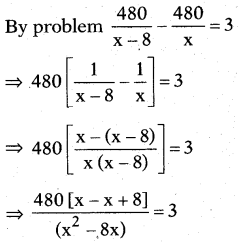
⇒ x2 - 8x = 1280
⇒ x2 - 8x - 1280 = 0
where x is the speed of the train.
Question 1.
Find the roots of the following quadratic equations by factorisation,
i) x2- 3x - 10 = 0
Answer:
Given: x2- 3x - 10 = 0
x2- 5x + 2x- 10 = 0
⇒ x(x - 5) + 2 (x - 5) = 0
⇒ (x - 5) (x + 2) = 0
⇒ x - 5 = 0 or x + 2 = 0
⇒ x = 5 or x = -2
⇒ x = 5 or -2
are the roots of the given Q.E.
ii) 2x2+ x - 6 = 0
Answer:
Given: 2x2+ x - 6 = 0
⇒ 2x2+ 4x - 3x - 6 = 0
⇒ 2x(x + 2) - 3(x + 2) = 0
⇒ (x + 2) (2x - 3) = 0
⇒ (x + 2) or 2x - 3 = 0
⇒ x = -2 or 2x = 3
⇒ x = -2 or 3/2
are the roots of the given Q.E.
iii) √2x2+ 7x + 5√2 =0
Answer:
Given: √2x2+ 7x + 5√2 =0
⇒ √2x2+ 5x + 2x + 5√2 = 0
⇒ x(√2x + 5)+ √2(√2x + 5) = 0
⇒ (√2x + 5) (x + √2) = 0
⇒ √2x + 5 = 0 or x + √2 = 0
⇒ √2x = -5 or x = -√2
⇒ x =-5/√2= or -√2
are the roots of √2 the given Q.E.
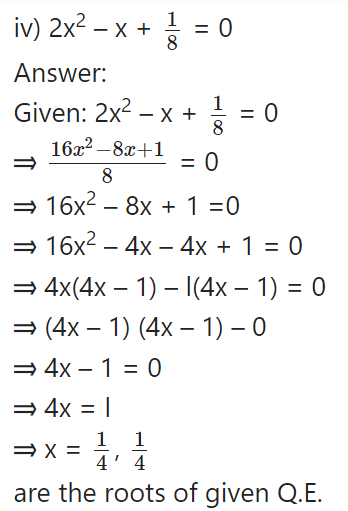
v) 100x2- 20x + 1 = 0
Answer:
Given : 100x2- 20x + 1 =0
⇒ 100x2- 10x - 10x + 1 = 0
⇒ 10x(10x - 1) - l(10x - 1) = 0
⇒ (10x - 1) (10x - l) = 0
⇒ 10x - 1 = 0
⇒ 10x = 1
⇒ x =1/10, 1/10
are the roots of the given Q.E.
vi) x(x + 4) = 12
Answer:
Given: x(x + 4) = 12
⇒ x2+ 4x = 12
⇒ x2+ 4x - 12 = 0
⇒ x2+ 6x - 2x - 12 = 0
⇒ x(x + 6) - 2(x + 6) = 0
⇒ (x + 6) (x - 2) = 0
⇒ x + 6 = 0 or x - 2 = 0
⇒ x = -6 or x = 2
⇒ x = -6 or 2
are the roots of the given Q.E.
vii) 3x2- 5x + 2 = 0
Answer:
Given: 3x2- 5x + 2 = 0
⇒ 3x2- 3x - 2x + 2 = 0
⇒ 3x(x - 1) - 2(x - 1) = 0
⇒ (x - 1) (3x - 2) = 0
⇒ x - 1 = 0 or 3x - 2 = 0
⇒ x = 1 or 2/3,
⇒ x = 1 or 2/3 are the roots of the given Q.E.
viii) x - 3/x = 2
Answer:
Given: x - 3/x = 2
⇒x2-3/x= 2
⇒ x2- 3 = 2x
⇒ x2- 2x - 3 = 0
⇒ x2- 3x + x - 3 = 0
⇒ x(x - 3) + l(x - 3) = 0
⇒ (x - 3) (x + 1) = 0
⇒ (x - 3) = 0 or (x + 1) = 0
⇒ x = 3 or x = -1
⇒ x = 3 or -1 are the roots of the given Q.E.
ix) 3(x - 4)2- 5(x - 4) = 12
Answer:
Take (x - 4) = a, then the given Q.E. reduces to 3a2- 5a = 12
⇒ 3a2- 5a - 12 = 0
⇒ 3a2- 9a + 4a - 12 = 0
⇒ 3a(a - 3) + 4(a - 3) = 0
⇒ (a - 3) (3a + 4) = 0
⇒ a - 3 = 0 or 3a + 4 = 0
⇒ a = 3 or a =-4/3
but a = x - 4
x - 4 = 3 (or) x - 4 = -4/3
⇒ x = 7 or x = 4 - -4/3=8/3
∴ x = 7 or 8/3
are the roots of the given Q.E.
Question 2.
Find two numbers whose sum is 27 and product is 182.
Answer:
Let a number be x.
Then the other number = 27 - x
Product of the numbers = x(27 - x) = 27x - x2
By problem 27x - x2= 182
⇒ x2- 27x + 182 = 0
⇒ x2- 14x - 13x + 182 = 0
⇒ x(x- 14) - 13(x - 14) = 0
⇒ (x - 13) (x - 14) = 0
⇒ x - 13 = 0 or x - 14 = 0
⇒ x = 13 or 14.
∴ The numbers are 13; 27 - 13 = 14 or 14 and 27 - 14 = 13.
Question 3.
Find two consecutive positive integers, sum of whose squares is 613.
Answer:
Let a positive integer be x.
Then the second integer = x + 1
Sum of the squares of the above integers = x2+ (x + 1)2
= x2+ x2+ 2x + 1
= 2x2+ 2x + 1
By problem 2x2+ 2x + 1 = 613
⇒ 2x2+ 2x - 612 = 0
⇒ x2+ x - 306 = 0
⇒ x2+ 18x - 17x - 306 = 0
⇒ x(x + 18) - 17(x + 18) = 0
⇒ (x - 17) (x + 18) = 0
⇒ x - 17 = 0 (or) x + 18 = 0
⇒ x = 17 (or) -18,
we do not consider -18
Then the numbers are (17, 17 + 1)
i.e., 17, 18 are the required two consecutive positive integers.
Question 4.
The altitude of a right triangle is 7 cm less than its base. If the hypotenuse is 13 cm, find the other two sides.
Answer:
Let the base of the right triangle = x cm
Then its altitude = x - 7 cm
By Pythagoras Theorem
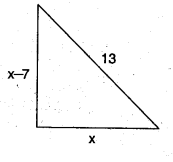
(base)2+ (height)2= (hypotenuse)2
⇒ x2+ (x - 7)2= 132
⇒ x2+ x2- 14x + 49 = 169 .
⇒ 2x2- 14x + 49 - 169 = 0
⇒ 2x2- 14x - 120 = 0
⇒ x2- 7x - 60 = 0
⇒ x2- 12x + 5x - 60 = 0
⇒ x(x - 12) + 5(x - 12) = 0
⇒ (x - 12) (x + 5) = 0
⇒ x - 12 = 0 (or) x + 5 = 0
⇒ x = 12 (or) x = -5 But x can’t be negative.
∴ x = 12
x - 7 = 12 - 7 = 5
The two sides are 12 cm and 5 cm.
Question 5.
A cottage industry produces a certain number of pottery articles in a day. It was observed on a particular day that the cost of production of each article (in rupees) was 3 more than twice the number of articles produced on that day. If the total cost of production on that day was Rs. 90, find the number of articles produced and the cost of each article.
Answer:
Let the number of articles produced be x.
Then the cost of each article = 2x + 3
Total cost of the articles produced = x [2x + 3] = 2x2+ 3x
By problem 2x2+ 3x = 90
⇒ 2x2+ 3x - 90 = 0
⇒ 2x2+ 15x - 12x - 90 = 0
⇒ x (2x + 15) - 6 (2x + 15) = 0
⇒ (2x + 15) (x - 6) = 0
⇒ 2x + 15 = 0 (or) x - 6 = 0
⇒ x = -15/2 or x = 6
But x can’t be negative.
∴ x = 6
2x + 3 = 2 × 6 + 3 = 15
∴ Number of articles produced = 6 Cost of each article = Rs. 15.
Question 6.
Find the dimensions of a rectangle whose perimeter is 28 meters and whose area is 40 square meters.
Answer:
Let the length of the rectangle = x
Given perimeter = 2(1 + b) = 28
⇒ (1 + b) = 28/2 = 14
Breadth of the rectangle = 14 - x
Area = length . breadth = x (14 - x)
= 14x - x2
By problem, 14x - x2= 40.
⇒ x2- 14x + 40 = 0
⇒ x2- 10x - 4x + 40 = 0
⇒ x(x - 10) - 4(x - 10) = 0
⇒ (x - 10) (x - 4) = 0
⇒ x - 10 = 0 (or) x - 4 = 0
⇒ x = 10 (or) 4
∴ Length = 10 m or 4 m
Then breadth = 14 - 10 = 4 m (or) 14 - 4 = 10 m
Question 7.
The base of a triangle is 4 cm longer than its altitude. If the area of the triangle is 48 sq.cm, then find its base and altitude.
Answer:
Let the altitude of the triangle h = x cm
Then its base ‘b’ = x + 4.
Area = 1/2 × base × height
=12(x + 4)(x)
=x2+4x/2
By problem x2+4x/2= 48
⇒ x2+ 4x = 2 × 48
⇒ x2+ 4x - 96 = 0
⇒ x2+ 12x - 8x - 96 = 0
⇒ x(x + 12) - 8(x + 12) = 0
⇒ (x + 12)(x - 8) = 0
⇒ x + 12 = 0 (or) x - 8 = 0
⇒ x = -12 (or) x = 8
But x can’t be negative.
∴ x = 8 and x + 4 = 8 + 4 = 12
Hence altitude = 8 cm and base = 12 cm.
Question 8.
Two trains leave a railway station at the same time. The first train travels towards west and the second train towards north. The first train travels 5 km/hr faster than the second train. If after two hours they are 50 km. apart, find the average speed of each train.
Answer:
Let the speed of the slower train = x kmph
Then speed of the faster train = x + 5 kmph.
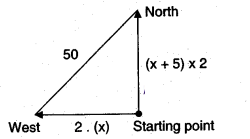
Distance = Speed × Time
Distance travelled by the first train = 2(x + 5) = 2x + 10
Distance travelled by the second train = 2.x = 2x
By Pythagoras Theorem
(hypotenuse)2= (side)2+ (side)2
⇒ (2x)2+ (2x + 10)22= 502
⇒ 4x2+ (4x2+ 40x + 100) = 2500
⇒ 4x2+ 4x2+ 40x + 100 = 2500
⇒ 8x2+ 40x - 2400 = 0
⇒ x2+ 5x - 300 = 0
⇒ x2+ 20x - 15x - 300 = 0
⇒ x (x + 20) - 15 (x + 20) = 0
⇒ (x + 20) (x - 15) = 0
∴ x - 15 = 0 (or) x + 20 = 0
⇒ x = 15 (or) - 20
But x can’t be negative.
∴ Speed of the slower train x = 15 kmph.
Speed of the faster train x + 5 = 15 + 5 = 20 kmph.
Question 9.
In a class of 60 students, each boy contributed rupees equal to the number of girls and each girl contributed rupees equal to the number of boys. If the total money then collected was Rs. 1600, how many boys are there in the class?
Answer:
Let the number of boys in the class = x
Then number of girls in the class = 60 - x [∵ total students = 60]
Money contributed by the boys = x(60 - x) = 60x - x2[∵ given]
Money contributed by the girls = (60 - x)x = 60x - x2
∴ Money contributed by the class = 120x - 2x2
By problem 120x -2x2= 1600
⇒ 2x2- 120x + 1600 = 0
⇒ x2- 60x + 800 = 0
⇒ x2- 40x - 20x + 800 = 0
⇒ x(x - 40) - 20 (x - 40) = 0
⇒ (x - 40) (x - 20) = 0
⇒ x = 40 (or) 20
∴ Boys = 40 or 20 Girls = 20 or 40.
Question 10.
A motor boat heads upstream a distance of 24 km on a river whose current is running at 3 km per hour. The trip up and back takes 6 hours. Assuming that the motor boat maintained a constant speed, what was its speed ?
Answer:
Let the speed of the boat in still water be x kmph.
Speed of the current = 3 kmph
Then speed of the boat in upstream = (x - 3) kmph
Speed of the boat in downstream = (x + 3) kmph
By problem total time taken = 6h.
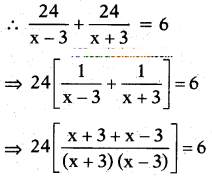
⇒ 24(2x) = 6(x2- 9)
⇒ 8x = x2- 9
⇒ x2- 8x - 9 = 0
⇒ x2- 9x + x-9 = 0
⇒ x (x - 9) + 1 (x - 9) = 6
⇒ (x - 9) (x + 1) = 0
⇒ x - 9 = 0 or x + 1 = 0
x can’t be negative,
∴ x = 9
i.e., speed of the boat in still water = 9 kmph.
Question 1.
Find the roots of the following quadratic equations, if they exist, by the method of completing the square:
i) 2x2+ x - 4 = 0
Answer:
Given: 2x2+ x - 4 = 0
⇒ 2x2+ x = 4
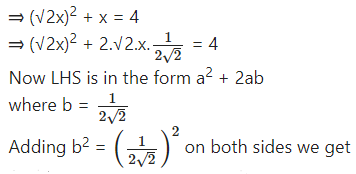

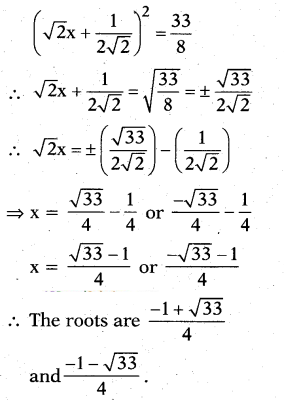
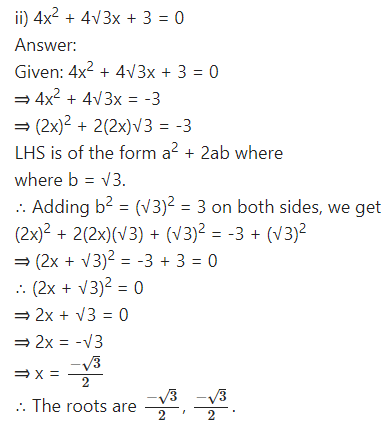
iii) 5x2- 7x - 6 = 0
Given quardratic equation = 5x2- 7x - 6 = 0
∴ 5x2- 7x - 6
⇒ x2-7/5 x =6/5, it can be re-written as
x2 - 2.710x =6/5 now it is in the form
of a2- 2ab where a = x, and b =7/10
Now adding b2=(7/10)2on both sides, we get

Note: If we take the Q.E. as 5x2 - 7x + 6 = 0, then we get the T.B. answer.
iv) x2+ 5 = -6x
Answer:
The given Q.E. is x2+ 5 = -6x
⇒ x2+ 6x = -5
⇒ (x)2+ 2.(x).3 = -5
Now L.H.S. is of the form a2+ 2ab where b = 3.
Adding b2= 32on both sides we get
x2+ 2(x)(3) + 32= -5 + 32
(x + 3)2= -5 + 9 = 4
∴ x + 3 = 74 = ± 2
⇒ x = +2 - 3 or - 2 - 3
= -1 or -5 are the roots of the given Q.E.
Question 2.
Find the roots of the quadratic equations given in Q.1 above by applying the quadratic formula,
i) 2x2+ x - 4 = 0
Answer:
Comparing this Q.E. with ax2+ bx + c = 0
a = 2; b = 1; c = -4
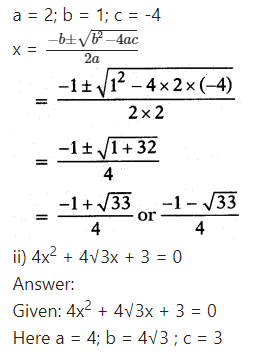
ii) 4x2 + 4√3x + 3 = 0
Answer:
Given: 4x2 + 4√3x + 3 = 0
Here a = 4; b = 4√3 ; c = 3
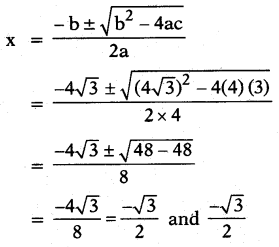
iii) 5x2 - 7x - 6 = 0
Answer:
Given: 5x2 - 7x - 6 = 0
Here a = 5; b = -7 and c = -6
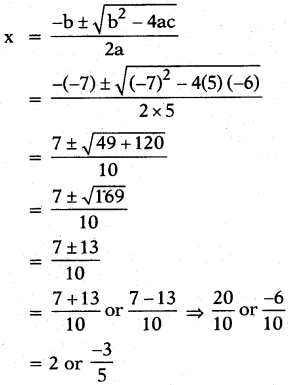
iv) x2 + 5 = -6x
Answer:
Given: x2 + 5 = -6x
⇒ x2 + 6x + 5 = 0
Here a = 1; b = 6; c = 5
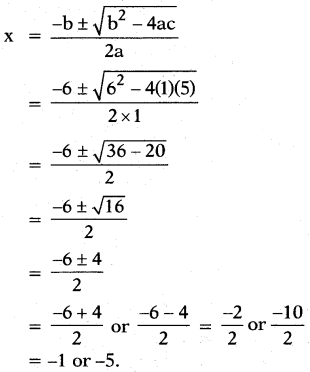
Question 3.
Find the roots of the following equations:
i) x - 1/x = 3, x ≠ 0
Answer:
Given: x - 1/x = 3
⇒ x2 + 6x + 5 = 0
⇒ x2-1/x = 3
⇒ x2 - 1 = 3x
⇒ x2 - 3x - 1 = 0
Here a = 1; b = -3; c = -1

ii) 1/x+4 - 1/x-7 = 11/30, x ≠ -4, 7
Answer:
Given: 1/x+4 - 1/x-7 = 11/30
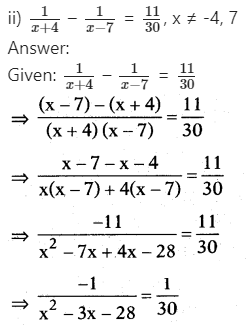
⇒ x2 - 3x - 28 = -30
⇒ x2 - 3x - 28 + 30 = 0
⇒ x2 - 3x + 2 = 0
⇒ x2 - 2x - x + 2 = 0
⇒ x(x - 2) - 1(x - 2) = 0
⇒ (x - 2) (x - 1) = 0
⇒ x - 2 = 0 (or) x - 1 = 0
⇒ x = 2 or x = 1
⇒ x = 2 or 1.
Question 4.
The sum of the reciprocals of Rehman’s ages, (in years) 3 years ago and 5 years from now is 1/3. Find his present age.
Answer:
Let the present age of Rehman be x years.
3 years ago Rehman’s age = x - 3 and its reciprocal is 1/x-3
Rehman’s age 5 years from now = x + 5 and its reciprocal is1/x+5
The sum of the reciprocals
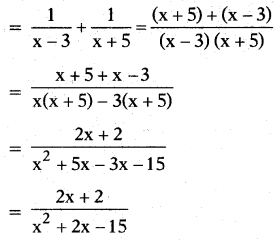

⇒ x2 + 2x - 15 = 3(2x + 2)
⇒ x2 + 2x - 15 = 6x + 6
⇒ x2 + 2x - 15 - 6x - 6 = 0
⇒ x2 - 4x - 21 =0
⇒ x2 - 7x + 3x - 21 =0
⇒ x(x - 7) + 3(x - 7) 0
⇒ (x - 7) (x + 3) = 0
⇒ x - 7 = 0 or x + 3 = 0
⇒ x = 7 or x = -3
But x can’t be negative, x = 7
i.e., Present age of Rehman = 7 years.
Question 5.
In a class test, the sum of Moulika’s marks in Mathematics and English is 30. If she got 2 marks more in Mathematics and 3 marks less in English, the product of her marks would have been 210. Find her marks in the two subjects.
Answer:
Sum of the marks in Mathematics and English = 30
Let Moulika’s marks in Mathematics be x Then her marks in English = 30 - x
If she got 2 more marks in Mathematics, then her marks would be x + 2.
If she got 3 marks less in English then her marks would be 30 - x - 3 = 27 - x
By problem (x + 2) (27 - x) = 210
⇒ x(27 - x) + 2(27 - x) = 210
⇒ 27x - x2 + 54 - 2x = 210
⇒ -x2 + 25x + 54 = 210
⇒ x2 - 25x - 54 + 210 = 0
⇒ x2 - 25x + 156 = 0
⇒ x2 - 12x - 13x + 156 = 0
⇒ x(x - 12) - 13(x 12) = 0
⇒ (x - 12) (x - 13) = 0
⇒ x - 12 = 0 or x - 13 = 0
⇒ x = 12 or x = 13
If x = 12, then marks in Mathematics = 12 English = 30 - 12 = 18
If x = 13, then marks in Mathematics = 13 English = 30 - 13 = 17
Question 6.
The diagonal of a rectangular field is 60 metres more than the shorter side. If the longer side is 30 metres more than the shorter side, find the sides of the field.
Answer:
Let the shorter side of the rectangular field = x m.
Then its longer side = x + 30 m.

The diagonal of a rectangle is also the hypotenuse of the lower triangle Here the diagonal = x + 60
∴ By Pythagoras Theorem
(side)2 + (side)2 = (hypotenuse)2
⇒ (x + 30)2 + x2 = (x + 60)2
⇒ x2 + 60x + 900 + x2 = x2 + 120x + 3600
⇒ x2 - 60x - 2700 = 0
⇒ x2 - 90x + 30x - 2700 = 0
⇒ x(x - 90) + 30 (x - 90) = 0
⇒ (x - 90) (x + 30) = 0
⇒ x - 90 = 0 (or) x + 30 = 0
⇒ x = +90 (or) x = -30 But x cant be negative.
∴ x = 90 m
i.e., the shorter side x = 90 m Longer side x + 30 = 90 + 30 = 120 m.
Question 7.
The difference of squares of two numbers is 180. The square of the smaller number is 8 times the larger number. Find the two numbers.
Answer:
Let the large number be x.
8 times larger number = Square of the srnall number = 8x
Square of the larger number = x2
By problem, x2 - 8x = 180
⇒ x2 - 8x - 180 = 0
⇒ x2- 18x + 10x - 180 = 0
⇒ x(x - 18) + 10(x - 18) = 0
⇒ (x + 10)(x - 18) = 0
⇒ x + 10 = 0 (or) x - 18 = 0
⇒ x = -10 (or) x = 18
If x = 18, then larger number =18;
(small number)2 = 8 × (+18) = 144
∴ Small number = √144 = 12
The numbers are 18, 12
Note: Discard x = -10.
Question 8.
A train travels 360 km at a uniform speed. If the speed had been 5 km/h more, it would have taken 1 hour less for the same journey. Find the speed of the train.
Answer:
The distance travelled = 360 km.
Let the speed of the train = x kmph.
Time taken to complete a journey =distance/speed
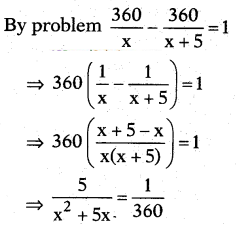
⇒ x2 + 5x = 1800
⇒ x2 + 5x - 1800 = 0
⇒ x2 + 45x - 40x - 1800 = 0
⇒ x(x + 45) - 40(x + 45) = 0
⇒ (x + 45) (x - 40) = 0
x + 45 = 0 or x -40 = 0
x = -45 or x = +40
But x cant be negative.
∴ The speed of the train = 40 kmph.
Question 9.
Two water taps together can fill a tank in 9 3/8 hours. The tap of larger diameter takes 10 hours less than the smaller one to fill the tank separately. Find the time in which each tap can separately fill the tank.
Answer:
Let the time taken to fill the tank by smaller tap = x (hours)
So the part filled by smaller tap in
1 hour = 1/x × 75/8 = 75/8x ……. (1)
Again then the time taken to fill the tank by larger tap = (x - 10) hours
∴ the part of tank that can be filled by larger tap alone in one hour of time = 1/x-10
∴ In 75/8 hours the part filled by larger tap = 75/8 (1/x-10)
∴ By both taps together
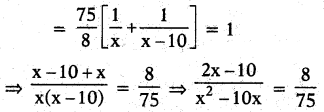
⇒ 150x - 750 = 8x
2 - 80x
⇒ 8x
2 - 80x - 150x + 750 = 0
⇒ 8x
2 - 230x + 750 = 0
⇒ 4x
2 - 115x + 375 = 0
⇒ 4x
2 - 100x - 15x + 375 = 0
⇒ 4x(x - 25) - 15(x - 25) = 0
∴ (4x - 15) (x - 25) = 0 15
⇒ 4x = 15, x = 15/4 or x = 25
x = 25 hours.
then time taken to fill by larger tap = x - 10 = 25 - 10 = 15 hours
(x cannot be 15/4 since we have considered x as time taken by smaller tap, which is to be higher one)
Question 10.
An express train takes 1 hour less than a passenger train to travel 132 km between Mysore and Bangalore (without taking into consideration the time they stop at intermediate stations). If the average speed of the express train is 11 km/hr more than that of the passenger train, find the average speed of the two trains.
Answer:
Let the speed of the passenger train = x kmph.
Then speed of the express train = x + 11 kmph.
Distance travelled = 132 km
We know that time = distance/speed
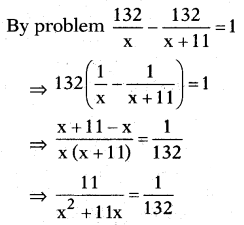
⇒ x2 + 11x = 13 × 11
⇒ x2 + 11x - 1452 = 0
⇒ x2 + 44x - 33x - 1452 = 0
⇒ x(x + 44) - 33 (x + 44) = 0
⇒ (x + 44) (x - 33) = 0
⇒ x + 44 = 0 (or) x - 33 = 0
⇒ x = -44 (or) x = 33
But x cant be negative.
∴ Speed of the passenger train = x = 33 kmph.
Speed of the express train = x + 11 = 44 kmph.
Question 11.
Sum of the areas of two squares is 468 m2. If the difference of their perimeters is 24m, find the sides of the two squares.
(OR)
If the sum of the areas of two squares is 468 m2 and the difference of their perimeters is 24m, then find the measurements of their sides.
Answer:
Let the side of first square = x m say Then perimeter of the first square = 4x [∵ P = 4 . side]
By problem, perimeter of the second square = 4x + 24 (or) 4x - 24
∴ Side of the second square =
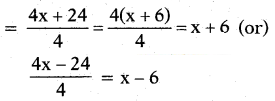
Now sum of the areas of the two squares is given as 468 m2
x2 + (x + 6)2 = 468
⇒ x2 + x2 + 12x + 36 = 468
⇒ 2x2 + 12x + 36 - 468 = 0
⇒ 2x2 + 12x - 432 = 0
⇒ x2 + 6x - 216 = 0
⇒ x2 + 18x - 12x - 216 = 0
⇒ x(x + 18)- 12(x + 18) = 0
⇒ (x + 18) (x - 12) = 0
⇒ x + 18 = 0 (or) x - 12 = 0
⇒ x = -18 (or) 12
But x cant be negative.
∴ x = 12
i.e., side of the first square = 12
∴ Perimeter = 4 × 12 = 48
∴ Perimeter of the second square = 48 + 24 = 72
∴ Side of the second square = 72/4 = 18 m.
(or)
x2 + (x - 6)2 = 468
⇒ x2 + x2 - 12x + 36 = 468
⇒ 2x2 - 12x - 432 - 0
⇒ x2 - 6x - 216 = 0
⇒ x2 - 18x + 12x - 216 = 0
⇒ x(x-18) + 12(x-18) = 0
⇒ (x - 18) (x + 12) = 0
⇒ x - 18 = 0 (or) x + 12 = 0
⇒ x = 18 (or) - 12
But x cant be negative.
∴ x = 18
i.e., side of the first square = 18 m
∴ Perimeter = 4 × 18 = 72
Perimeter of the second square = 72 - 24 = 48
∴ Side of the second square = 48/4 = 12 m.
i.e., In any way, the sides of the squares are 12m, 18m.
Question 12.
If a polygon of ‘n’ sides has 1/2n(n - 3) diagonals. How many sides will a polygon having 65 diagonals? Is there a polygon with 50 diagonals?
Answer:
Given: Number of diagonals of a polygon with n-sides = n(n-3)/2
No. of diagonals of a given polygon = 65
i.e.,n(n-3)/2= 65
where n is number of sides of the polygon
where n is number of sides of the polygon
⇒ n2 - 3n = 2 × 65
⇒ n2 - 3n - 130 = 0
⇒ n2 - 13n + 10n - 130 = 0
⇒ n(n - 13) + 10(n - 13) = 0
⇒ (n - 13) (n + 10) = O
⇒ n - 13 = 0 (or) n + 10 = 0
⇒ n = 13 (or) n = -10
But n can’t be negative.
∴ n = 13 (i.e.) number of sides = 13.
Also to check 50 as the number of diagonals of a polygon
∴ n(n-3)/2 = 50
⇒ n2 - 3n = 100
⇒ n2 - 3n - 100 = 0
There is no real value of n for which the above equation is satisfied.
∴ There can’t be a polygon with 50 diagonals.
Question 1.
Find the nature of the roots of the following quadratic equations. If real roots exist, find them.
i) 2x2- 3x + 5 = 0
Answer:
Given: 2x2- 3x + 5 = 0
a = 2; b = -3; c = 5
Discriminant = b2- 4ac
b2- 4ac = (-3)2- 4(2)(5)
= 9 - 40
= -31 < 0
∴ Roots are imaginary.
ii) 3x2- 4√3x + 4 = 0
Answer:
Given: 3x2- 4√3x + 4 = 0
a = 3; b = -4√3; c = 4
b2- 4ac = (-4√3)2- 4(3)(4)
= 48 - 48 = 0
∴ Roots are real and equal and they
-b/2a , -b/2a

iii) 2x2 - 6x + 3 = 0
Answer:
Given: 2x2 - 6x + 3 = 0
a = 2; b = -6; c = 3
b2 - 4ac = (-6)2 - 4(2)(3)
= 36 - 24
= 12 > 0
∴ The roots are real and distinct. They are
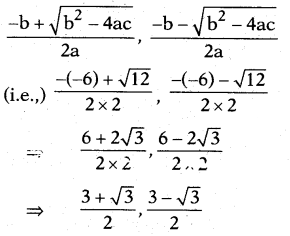
Question 2.
Find the values of k for each of the fol-lowing quadratic equations so that they have two equal roots.
i) 2x2+ kx + 3 = 0
Answer:
Given : 2x2+ kx + 3 = 0 has equal roots
∴ b2- 4ac = 0
Here a = 2; b = k; c = 3
b2- 4ac = (k)2- 4(2)(3) = 0
⇒ k2- 24 = 0
⇒ k2= 24
⇒ k = √24 = ± 2√6
ii) kx(x - 2) + 6 = 0
Answer:
Given: kx(x - 2) + 6 = 0
kx2- 2kx + 6 = 0
As this Q.E. has equal roots,
b2- 4ac = 0
Here
a = k; b = -2k; c = 6
∴ b2- 4ac = (-2k)2- 4(k)(6) = 0
⇒ 4k2- 24k = 0
⇒ 4k(k - 6) = 0
⇒ 4k = 0 (or) k - 6 = 0
⇒ k = 0 (or) 6
But k = 0 is trivial
∴ k = 6.
Question 3.
Is it possible to design a rectangular mango grove whose length is twice its breadth, and the area is 800 m2- If so, find its length and breadth.
Answer:
Let the breadth = x m
Then length = 2x m
Area = length x breadth = x.(2x)
= 2x2m2
By problem 2x2= 800 ⇒ x2= 400
and x = √400 = ± 20
∴ Breadth x = 20 m and
length 2x = 2 × 20 = 40 m.
Question 4.
The sum of the ages of two friends is 20 years. Four years ago, the product of their ages in years was 48. Is the above situation possible? If so, deter¬mine their present ages.
Answer:
Let the age one of the two friends be x years.
Then the age of the other = 20 - x
Then, 4 years ago their ages would be (x - 4) and (20 - x - 4) = 16 - x
∴ Product of their ages 4 years ago = (x - 4) (16 - x)
By problem (x - 4) (16 - x) = 48
⇒ x(16 - x) - 4(16 - x) = 48
⇒ 16x - x2- 64 + 4x = 48
⇒ x2- 20x + 112 = 0
Here a = 1; b = -20; c = 112
b2- 4ac = (-20)2- 4(1) (112)
= 400 - 448
= -48 < 0
Thus the roots are not real.
∴ The situation is not possible.
Question 5.
Is it possible to design a rectangular park of perimeter 80 m and area 400 m2- If so, find its length and breadth.
Answer:
Given: Perimeter of a rectangle 2(1 + b) = 80
⇒ 6 + b = 80/2 = 40
Area of the rectangle, l × b = 400
If possible, let us suppose that length of the rectangle = x m say
Then its breadth by equation (1) = 40 - x
By problem area = x . (40 - x) = 400
⇒ 40x - x2= 400
⇒ x2 - 40x + 400 = 0
Here a = 1; b = -40; c = +400
b2 - 4ac = (-40)2 - 4(1)(+400)
= 1600 - 1600 = 0
∴ The roots are real and equal.
They are -b2/a, -b/2a
i.e., -(-40)/2×1 = 40/2 = 20
∴ The dimensions are 20 m, 20 m.
(∴ The park is in square shape)